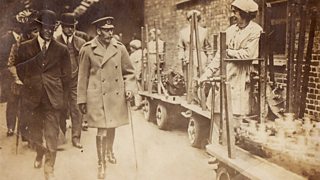How close was Britain to following Russia in revolution in 1917?
In 1917, as Lenin’s Bolshevists seized power in Russia and set about creating a communist regime, there was a genuine fear that revolution could come to Britain. Throughout the year industrial unrest had been growing and by November 1917 almost one million working days were lost to strikes – the highest figure during all of WWI. Could a feeling of discontent amongst the working classes have been harnessed by a movement that sought to overthrow the Government?

This was certainly the worry of the governing classes. An intelligence report sent to the Minister of Munitions concluded that industrial discontent was being stirred up by revolutionary organisations. “Labour is stronger than parliament at the moment”, said the report, which also expressed concern for official assessments of industrial unrest hopelessly underestimated the danger.
Dr Martin Farr of Newcastle University highlights the Lansdowne letter as an illustration of the fear of revolution in Britain. Dr Farr explains Lord Lansdowne, a right-wing unionist, “called for a negotiated settlement to the war because he feared that its continuation would lead to revolution or at least an undermining of the established order of society.”
An old order feared they would lose their long-held positions of power.
Lansdowne’s letter, which was published in The Daily Telegraph in November 1917, was publicly largely dismissed, but Dr Adrian Gregory of the University of Oxford says the British State still took action to guard against any revolutionary sentiment.
There was a redoubling of propaganda as well as the utilisation of the secret State and surveillance. “There was a mass effort of sending out speakers and putting on propaganda films, presenting idealistic war aims and beginning to talk about domestic reconstruction but there was also the sending out of spies to find socialist pacifist plots”, says Dr Gregory, author of The Last Great War.
Increasingly unionised and politically active
A place of particular concern for the Government was what became dubbed as “Red Clydeside”. The greater Glasgow area was a huge industrial hub engaged in meeting the enormous demand for munitions and navy vessels. This meant it has a considerable working class populace which over the course of WWI became increasingly unionised and politically active. The Clyde Workers’ Committee was one of the organisations that was feared to be stirring up revolutionary feelings. Another was the No-Conscription Fellowship which had its offices raided by police on 14 November 1917.
As part of the concerted effort to recommit the population to the war effort, the National War Aims Committee was formed to focus on propaganda at home. And a key target audience for this propaganda was industrial workers. Dr Gregory explains, “The Government was dependent on the industrial worker for the war effort. It signalled to industrial employers that it didn’t appreciate places like munitions factories standing idle.
“This meant that when workers went on strike, industrial employers would often come to some kind of settlement relatively quickly. Understandably, strikes picked up because people noticed that they worked.”
In Season 12 of Home Front, Marshalls munitions factory workers go on strike.
The industrial unrest that was seen through 1917 often grew out of localised issues but there was also a general element of war fatigue. Wages were continuing to be outstripped by the cost of living and food shortages were kicking in. Meanwhile, not only could work be physically hard and in dangerous conditions, workers felt unfairly treated.
Dr Gregory explains, “There was a sense amongst skilled, male workers that to some extent they had lost their liberty and freedom of action with things like leaving certificates (required before working somewhere else) and restriction on industrial action (unions making pacts with the Government).
The Government was dependent on the industrial worker for the war effort.Dr Adrian Gregory
“There was a real resentment of profiteering. This really offended people. If there was money to be made out of the war it should benefit all workers not just the bosses – the sacrifices the workers were making shouldn’t be lining their bosses’ pockets.” With this mistrust of management, it is unsurprising that union membership double from four million in 1914 to eight million in 1918.
Improving working class life
According to Dr Gregory while the British State had a genuine paranoia of revolution it was “a million miles from reality”. He points out that the strikes of 1917 and 1918 were relatively modest affairs with fewer working days lost to strikes during the entire war than had been in 1912.
While the overthrow of Tsarism, and an end to autocracy, in Russia earlier on in 1917 had been exciting for working classes, the later Bolshevist revolution initially held less significance. “There was an ambilavence about Bolshevists even in working class circles”, says Dr Gregory, “what’s more people with socialist beliefs weren’t necessarily revolutionary defeatists. Very few people subscribed to that in Britain – actively working for the defeat of your own country is beyond pacifism.”
Fundamentally the unrest in Britain in 1917 was not about a lack of patriotism, but taking advantage of an opportunity to improve working class life. Dr Gregory says, “There was a sense of taking advantage of the situation to push social change. The Government was dependent on industrial workers so that bargaining power was used while they had it. There is some evidence that trade unions knew just how long to withdraw workers to put pressure on the Government without endangering the war effort.”
He adds, “We tend to forget just how tough working class life was at the start of the 20th Century and when you consider that the demands of strikers don’t seem so unreasonable.”




